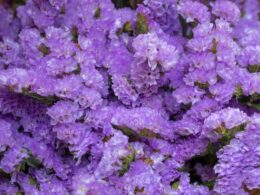The Balloon flower, or Platycodon grandiflorus, is a unique perennial flowering plant that can be found in gardens across the United States. With their interesting flower shape and spectacular blooms, they are definitely a plant worth considering if you’re looking for something new to add to your garden.
Balloon Flower (Platycodon grandiflorus) – Morphology
The balloon flower is a unique and intriguing plant. Its name comes from the shape of its flower buds, which resemble small balloons. After opening, these balloon-like buds change into star-shaped flowers.
The balloon plant is native to East Asia, and has been cultivated there for centuries. It was first introduced to the West in the late 18th century, and has become a popular garden plant.
The balloon flower is a member of the Campanulaceae family, which includes other well-known flowers such as bellflowers (Campanula spp.) and lobelia (Lobelia spp.). The plant grows to a height of 12-24 in (30-60 cm), with erect, branching stems. The leaves are lanceolate, and grow in pairs along the stem. The flowers are borne singly or in clusters of 2-5, at the ends of the stems. They are large and showy, with five petals that are fused together at the base, forming a balloon-like shape. The flowers are white and pink, or deep blue in color, and their bloom time is from late summer to fall.
This plant is also known as a Chinese bellflower and is popular as cut flowers for weddings and other occasions. Isn’t that beautiful?
Balloon Flower Plants – Growing Guide
If you’re looking for a plant that will add some blue flowers to your garden, consider growing balloon flowers. These beautiful plants come in a variety of colors, including purple, pink, and white, but the most popular are blue balloon plants.
Balloon flowers are relatively easy to grow and care for, and here are some tips to do it properly.
Watering
Balloon flowers need to be kept moist, but not soggy. Water them about once a week, or more often if the weather is particularly hot or dry. Be sure to water the plants at the base, rather than from above, to avoid getting water on the leaves, which can promote fungal growth.
Fertilizing & Pruning
Fertilize your balloon flowers once a month with a balanced fertilizer. You can also add some compost to the soil to help provide nutrients.
After the plants have bloomed, you can cut back the stems to about 6 inches (15 cm) to encourage new growth. You can also remove any dead or dying leaves or stems.
Soil & Sunlight
Balloon flowers need well-drained, sandy soil. If your soil is particularly heavy, you can add some perlite or sand to it to lighten it up.
Balloon flowers prefer full sun and need at least six hours of sunlight per day. They can tolerate partial shade, but they won’t bloom as well in these conditions.
When to Plant
Balloon flowers are typically planted in the spring, after the last frost date. You can also start them indoors about six weeks before that date.
Do Balloon Flowers Self Seed?
Yes, balloon flowers do self-seed quite readily. If you don’t want them to spread throughout your garden, it’s best to deadhead the spent blossoms before they go to seed. You can also dig up the plant in fall and divide it into smaller clumps to replant elsewhere. Balloon flowers are a hardy plant and will come back year after year with very little care.
Balloon Flower – Common Pests and Diseases
The balloon flower is a beautiful plant that can add color and life to any garden. However, like all plants, it is susceptible to pests and diseases. Here are some of the most common problems that affect balloon flowers:
Pests
- Aphids – these small, soft-bodied insects feed on the sap of plants, which can weaken and even kill the plant.
- Spider mites – these tiny creatures are actually related to spiders, and they feed on plant sap too. They can cause the leaves of the plant to turn yellow and drop off.
Diseases
- Powdery mildew – this fungal disease appears as a white powder on the leaves of the plant. It can cause the leaves to turn yellow and drop off.
- Leaf spot – this fungal disease appears as brown or black spots on the leaves of the plant. It can cause the leaves to turn yellow and drop off.
- Root rot – this fungal disease affects the roots of the plant, causing them to rot. This can kill the plant.
Now you know everything about this plant, and you can grow your own beautiful balloon flower in the garden!



















